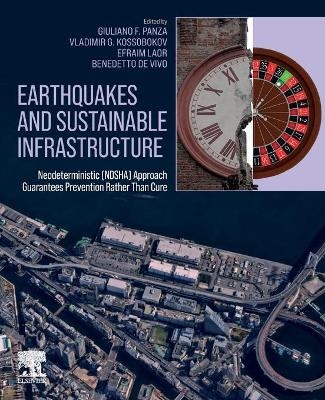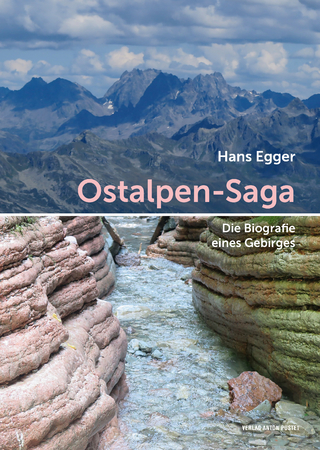
Earthquakes and Sustainable Infrastructure
Elsevier Science Publishing Co Inc (Verlag)
978-0-12-823503-4 (ISBN)
This book describes in a complete and consistent way an effective explanation to complex structures, systems, and components, and prescribes solutions to practical challenges. It reflects the scientific novelty and promises a feasible, workable, theoretical and applicative attitude.
Earthquakes and Sustainable Infrastructure serves a “commentary role for developers and designers of critical infrastructure and unique installations. Commentary-like roles follow standard, where there is no standard.
Mega-installations embody/potentiate risks; nonetheless, lack a comprehensive classic standard. Every compound is unique, one of its kind, and differs from others even of similar function. There is no justification to elaborate a common standard for unique entities. On the other hand, these specific installations, for example, NPPs, Naval Ports, Suez Canal, HazMat production sites, and nuclear waste deposits, impose security and safety challenges to people and the environment. The book offers a benchmark for entrepreneurs, designers, constructors, and operators on how to compile diverse relevant information on site-effects and integrate it into the best-educated guess to keep safe and secure, people and environment.
The authors are eager to convey the entire information and explanations to our readers, without missing either accurate information or explanations. That is achieved by “miniaturization, as much is possible, not minimization.
So far, the neodeterministic method has been successfully applied in numerous metropolitan areas and regions such as Delhi (India), Beijing (China), Naples (Italy), Algiers (Algeria), Cairo (Egypt), Santiago de Cuba (Cuba), Thessaloniki (Greece), South-East Asia (2004), Tohoku, Japan (2011), Albania (2019), Bangladesh, Iran, Sumatra, Ecuador, and elsewhere. Earthquakes and Sustainable Infrastructure includes case studies from these areas, as well as suggested applications to other seismically active areas around the globe. NDSHA approaches confirm/validate that science is looming to warn. Concurrently, leaders and practitioners have to learn to use rectified science in favor of peoples' safety. State-of-the-art science does have the know-how to reduce casualties and structural damage from potential catastrophes to a bearable incident.
Giuliano F. Panza is former Full Professor of Geophysics, Trieste University, Head SAND Group Abdus Salam ICTP Trieste, co-funded with Academician Vladimir Keilis-Borok; Dr.H.C. Bucharest University; Emeritus Honorary Professor at IGG-CEA, and Honorary Professor at BUCEA, China. Mr. Zhao Ming, Deputy Director CEA of Department International Cooperation welcomed him as Marco Polo in Seismology. He is a member of Accademia Nazionale dei Lincei, Accademia Nazionale delle Scienze detta dei XL, Academia Europaea, Russian Academy of Sciences, TWAS Academy, and a recipient of the EGU Beno Gutenberg medal, AGU International award, Premio Linceo ANL, Central European Initiative Medal of Honour, Commemorative Medal VAST, Medal of Honor NRIAG Egypt; 5th Class/Knight-OMRI for very high scientific merits, and is widely recognized for his links to fundamental results in geophysics with implications of great interest for the community. In 2009, he delivered the Lectio Magistralis opening Trieste University Academic year, attended by Chamber of Deputies President. His research interests include earthquake prediction and hazards, and geodynamics, and he has an h-index (Scopus) of 46. Vladimir Kossobokov is Past Vice President of the IUGG Commission of Geophysical Risk and Sustainability with an MS in Mathematics, Department of Mechanics and Mathematics, Moscow State University gained in 1975. Months before graduation he joined Vladimir Keilis-Borok (at that time Professor at Institute of Physics of the Earth, USSR Academy of Sciences) to work on pattern recognition of highly earthquake-prone areas. Their fruitful collaboration lasted for decades, and since then Professor Kossobokov has played a pioneering role in design and testing reproducible methods for earthquake prediction, hazards, and risks assessment based on global and regional geophysical databases through exploratory data analysis, pattern recognition, and applied mathematical statistics. His fundamental contributions have led to formulation of the Unified Scaling Law for Earthquakes, with the launching in 1992 of the on-going real-time intermediate-term earthquake prediction experiment that eventually confirmed (with a statistical confidence above 99%) the predictability of the world’s largest earthquakes, a better understanding of climates in Europe, and solar–terrestrial interactions. Efraim Laor received his PhD in Policy, Strategy and Administration of Large-Scale Emergency Situations (Disaster Management) from King’s College London. His work involves short and long-term strategic, operative, and tactical planning, as a member of think-tank teams that formulated conceptions for the “Emergencies and Battlefield of the Future. He has ample operational experience, was the CO of the 7th Armored Brigade, IDF, and was involved in numerous search and rescue, relief, and reconstruction missions in Israel and abroad in response to and recovery from earthquakes, tsunami, floods, typhoon, cyclone, fires, NaTech, HoTech, pandemia, nuclear disasters, and civil strife. He has been invited as lecturer and keynote speaker at numerous conferences, seminars, and training events. Benedetto De Vivo, after graduation (1971) from the University of Naples Federico II in Geological Sciences and military service (1972), worked for private companies operating in Italy, Africa, and Central America in the field of ore deposits, geochemical prospecting, environmental geology, and hydrogeology (1973–1977). Later, he was a Researcher at CNR-Roma, Italy (1977–1987), Associate Professor in Applied Geochemistry (1987–2000), and Full Professor in Geochemistry at the University of Napoli Federico II (2000–2017). He was a research fellow at the Colorado School of Mines (1978) and at US Geological Survey, Reston, VA (1982 and 1992); Chairman of the Working Group “Inclusions in Minerals of the International Mineralogical Association; Member of the Editorial Board of GEEA (2004–2007), Minerology and Petrol (1997–2007), American Mineralogist, and Chief Editor of Journal of Geochemical Exploration (2007–2017). His research interests span a wide range of topics including geochemical prospecting, fluid and melt inclusions studies on volcanic and sub-volcanic systems, and environmental geochemistry. He has published about 300 papers (in top international peer-reviewed journals), editing different special volumes (Journal of Volcanology and Geothermal Research, European Journal of Mineralogy, Institution of Mining and Metallurgy, and, Minerology and Petrol), and has authored four text books (in Italian) in geochemical prospecting and environmental geochemistry. He was nominated (2001) as Fellow of the Mineralogical Society of America and appointed as an Adjunct Professor at Virginia Tech, Blacksburg, VA, USA (2006), Nanjing University, China (2016), and Hubei Polytechnic University, Huansgshi, China (2019). He was the recipient of the 2019 Gold Medal Award of the Association of Applied Geochemists for outstanding scientific contributions and achievement in applied geochemistry.
1. Hazard, risks, and prediction Vladimir Kossobokov 2. Seismic hazard assessment from the perspective of disaster prevention Jens-Uwe Klugel 3. The view of a structural engineer about reliable seismic hazard assessment Paolo Rugarli 4. Disaster prediction and civil preparedness Efraim Laor and Benedetto De Vivo 5. The integration between seismology and geodesy for intermediate-term narrow-range earthquake prediction according to NDSHA Mattia Crespi, Vladimir Kossobokov, Antonella Peresan and Giuliano F. Panza 6. Modeling the block-and-fault structure dynamics with application to studying seismicity and geodynamics Alexander Soloviev 7. Morphostructural zoning for identifying earthquake-prone areas Alexander Gorshkov and Alexander Soloviev 8. Earthquake forecasting and time- dependent neo-deterministic seismic hazard assessment in Italy and surroundings Antonella Peresan and Leontina Romashkova 9. Spreading NDSHA application from Italy to other areas Fabio Romanelli, Giorgio Altin and Maurizio Indirli 10. S-wave velocity pro?ling for site response evaluation in urban areas Maria Rosaria Costanzo and Concettina Nunziata 11. A user-friendly approach to NDSHA computations Franco Vaccari and Andrea Magrin 12. Recent applications of NDSHA: seismic input for high rise buildings in Egypt’s New Administrative Capital Mohamed N. Elgabry, Hany M. Hassan and Hesham Hussein 13. Neodeterministic method to assess the seismic performance of water distribution networks Gian Paolo Cimellaro, Melissa De Iuliis and Sebastiano Marasco 14. Seismic hazard analysis in a historical context: experience at caltrans and elsewhere Lalliana Mualchin 15. Where there is no science - probabilistic hazard assessment in volcanological and nuclear waste settings: facts, needs, and challenges in Italy Benedetto De Vivo, Efraim Laor and Giuseppe Rolandi 16. Seismic hazard and earthquake engineering for engineering community Junbo Jia 17. Scenario-based seismic hazard analysis and its applications in the central United States Zhenming Wang, Seth N. Carpenter and Edward W. Woolery 18. NDSHA achievements in Central and South-eastern Europe Mihaela Kouteva-Guentcheva, Carmen Cio?an, Ivanka Paskaleva and Giuliano F. Panza 19. Application of NDSHA to historical urban areas Concettina Nunziata and Maria Rosaria Costanzo 20. Insights from neo-deterministic seismic hazard analyses in Romania Carmen Ortanza Cio?an, Elena Florinela Manea and Bogdan Felix Apostol 21. NDSHA in Bulgaria Mihaela Kouteva-Guentcheva, Ivanka Paskaleva and Giuliano F. Panza 22. NDSHA-based vulnerability evaluation of precode buildings in Republic of North Macedonia: Novel experiences Elena Dumova-Jovanoska and Kristina Milkova 23. Seismic characterization of Tiranae DurrëseLezha region (northwestern Albania) and analysis effort through NSHDA method Sokol Marku, Rapo Ormeni and Giuliano F. Panza 24. Regional application of the NDSHA approach for continental seismogenic sources in the Iberian Peninsula Mariano García-Fernández, Franco Vaccari, María-José Jiménez, Andrea Magrin, Fabio Romanelli and Giuliano F. Panza 25. NDSHA applied to China Yan Zhang, Lihua Fang, Fabio Romanelli,Zhifeng Ding, Shanghua Gao, Changsheng, Jiang and Zhongliang Wu 26. Application of neo-deterministic seismic hazard assessment to India Imtiyaz A. Parvez 27. Neo-deterministic seismic hazard assessment for Pakistan Farhana Sarwar, Franco Vaccari and Andrea Magrin 28. Neo-deterministic seismic hazard assessment studies for Bangladesh Tahmeed M. Al-Hussaini, Ishika N. Chowdhury, Hasan al Faysal, Sudipta Chakraborty, Franco Vaccari, Fabio Romanelli and Andrea Magrin 29. Application of NDSHA at regional and local scale in Iran Habib Rahimi and Mehdi Rastgoo 30. Application of neodeterministic seismic hazard analysis to Sumatra Irwandi Irwandi
| Erscheinungsdatum | 28.05.2021 |
|---|---|
| Sprache | englisch |
| Maße | 191 x 235 mm |
| Gewicht | 1310 g |
| Themenwelt | Naturwissenschaften ► Geowissenschaften ► Geologie |
| Naturwissenschaften ► Geowissenschaften ► Geophysik | |
| ISBN-10 | 0-12-823503-9 / 0128235039 |
| ISBN-13 | 978-0-12-823503-4 / 9780128235034 |
| Zustand | Neuware |
| Haben Sie eine Frage zum Produkt? |
aus dem Bereich


